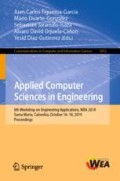Abstract
The ability to conduct fast and reliable simulations of dynamic systems is of special interest to many fields of operations. Such simulations can be very complex and, to be thorough, involve millions of variables, making it prohibitive in CPU time to run repeatedly for many different configurations. Reduced-Order Modeling (ROM) provides a concrete way to handle such complex simulations using a realistic amount of resources. However, when the original dynamical system is very large, the resulting reduced-order model, although much “thinner”, is still as tall as the original system, i.e., it has the same number of equations. In some extreme cases, the number of equations is prohibitive and cannot be loaded in memory. In this work, we combine traditional interval constraint solving techniques with a strategy to reduce the number of equations to consider. We describe our approach and report preliminary promising results.
Access this chapter
Tax calculation will be finalised at checkout
Purchases are for personal use only
References
Bai, Z., Meerbergen, K., Su, Y.: Arnoldi methods for structure-preserving dimension reduction of second-order dynamical systems. In: Benner, P., Sorensen, D.C., Mehrmann, V. (eds.) Dimension Reduction of Large-Scale Systems. LNCSE, vol. 45, pp. 173–189. Springer, Heidelberg (2005). https://doi.org/10.1007/3-540-27909-1_7
Benner, P., Quintana-Ortíz, E.: Model reduction based on spectral projection methods. In: Benner, P., Sorensen, D.C., Mehrmann, V. (eds.) Dimension Reduction of Large-Scale Systems. LNCSE, vol. 45, pp. 5–48. Springer, Heidelberg (2005). https://doi.org/10.1007/3-540-27909-1_1
Berkooz, G., Holmes, P., Lumley, J.: The proper orthogonal decomposition in the analysis of turbulent flows. Ann. Rev. Fluid Mech. 25(1), 539–575 (1993)
Cai, L., White, R.E.: Reduction of model order based on proper orthogonal decomposition for lithium-ion battery simulations. J. Electrochem. Soc. 156(3), A154–A161 (2009)
Ceberio, M., Granvilliers, L.: Horner’s rule for interval evaluation revisited. Computing 69(1), 51–81 (2002)
Flórez, H., Argáez, M.: Applications and comparison of model-order reduction methods based on wavelets and POD. In: Proceedings of 2016 Annual Conference of the North American Fuzzy Information Processing Society (NAFIPS), El Paso, TX, USA, pp. 1–8. IEEE (2016)
George, J., et al.: Idiopathic thrombocytopenic purpura: a practice guideline developed by explicit methods for the American Society of Hematology. Blood 88(1), 3–40 (1996)
Granvilliers, L., Benhamou, F.: Realpaver: an interval solver using constraint satisfaction techniques. ACM Trans. Math. Softw. (TOMS) 32(1), 138–156 (2006)
Hansen, E., Greenberg, R.: An interval newton method. Appl. Math. Comput. 12(2–3), 89–98 (1983)
Hansen, E., Walster, G.: Global Optimization Using Interval Analysis: Revised and Expanded, vol. 264. CRC Press, New York (2003)
Horner, W.G.: A new method of solving numerical equations of all orders, by continuous approximation. In: Philosophical Transactions of the Royal Society of London, New York, NY (1833)
Jaulin, L.: Applied Interval Analysis: With Examples in Parameter and State Estimation, Robust Control and Robotics. Springer, London (2001)
Kerschen, G., Golinval, J.: Physical interpretation of the proper orthogonal modes using the singular value decomposition. J. Sound Vibr. 249(5), 849–865 (2002)
Liang, Y., Lee, H., Lim, S., Lin, W., Lee, K., Wu, C.: Proper orthogonal decomposition and its applications, part i: theory. J. Sound Vibr. 252(3), 527–544 (2002)
Lin, Y., Stadtherr, M.: Validated solutions of initial value problems for parametric ODEs. Appl. Numer. Math. 57(10), 1145–1162 (2007)
Millet, A., Morien, P.: On implicit and explicit discretization schemes for parabolic SPDEs in any dimension. Stoch. Process. Their Appl. 115(7), 1073–1106 (2005)
Nedialkov, S.: Computing Rigorous Bounds on the Solution of an Initial Value Problem for an Ordinary Differential Equation. University of Toronto, Toronto, Canada (2000)
Rewienski, M., White, J.: A trajectory piecewise-linear approach to model order reduction and fast simulation of nonlinear circuits and micromachined devices. IEEE Trans. Comput.-Aided Des. Integr. Circ. Syst. 22(2), 155–170 (2003)
Sam-Haroud, D., Faltings, B.: Consistency techniques for continuous constraints. Constraints 1(1), 85–118 (1996)
Schilders, W.A., Van der Vorst, H., Rommes, J.: Model Order Reduction: Theory, Research Aspects and Applications. Springer, Berlin (2008)
Stahl, V.: Interval Methods for Bounding the Range of Polynomials and Solving Systems of Nonlinear Equations. Johannes-Kepler-Universität, Linz (1995)
Willcox, K., Peraire, J.: Balanced model reduction via the proper orthogonal decomposition. Am. Inst. Aeronaut. Astronaut. AIAA J. 40(11), 2323–2330 (2002)
Hassanalian, M., Throneberry, G., Abdelkefi, A.: Wing shape and dynamic twist design of bio-inspired nano air vehicles for forward flight purposes. Aerosp. Sci. Technol. 68, 518–529 (2017)
Hassanalian, M., Throneberry, G., Abdelkefi, A.: Investigation on the planform and kinematic optimization of bio-inspired nano air vehicles for hovering applications. Meccanica 53, 1–14 (2018)
Hassanalian, M., Throneberry, G., Abdelkefi, A.: Wing shape analysis and optimization of bio-inspired flapping wing nano air vehicles for forward flight. In: Proceeding of the SciTech 2017, AIAA Aerospace Sciences Meeting, AIAA Science and Technology Forum and Exposition 2017, Texas, USA, 09–13 January (2017)
Ghommem, M., et al.: Sizing and aerodynamic analysis of biplane flapping wing nano air vehicle: theory and experiment. In: Proceeding of the SciTech 2019, AIAA Aerospace Sciences Meeting, AIAA Science and Technology Forum and Exposition 2019, California, USA, 07–11 January (2019)
Author information
Authors and Affiliations
Corresponding author
Editor information
Editors and Affiliations
Rights and permissions
Copyright information
© 2019 Springer Nature Switzerland AG
About this paper
Cite this paper
Olumoye, O., Throneberry, G., Garcia, A., Valera, L., Abdelkefi, A., Ceberio, M. (2019). Solving Large Dynamical Systems by Constraint Sampling. In: Figueroa-García, J., Duarte-González, M., Jaramillo-Isaza, S., Orjuela-Cañon, A., Díaz-Gutierrez, Y. (eds) Applied Computer Sciences in Engineering. WEA 2019. Communications in Computer and Information Science, vol 1052. Springer, Cham. https://doi.org/10.1007/978-3-030-31019-6_1
Download citation
DOI: https://doi.org/10.1007/978-3-030-31019-6_1
Published:
Publisher Name: Springer, Cham
Print ISBN: 978-3-030-31018-9
Online ISBN: 978-3-030-31019-6
eBook Packages: Computer ScienceComputer Science (R0)

